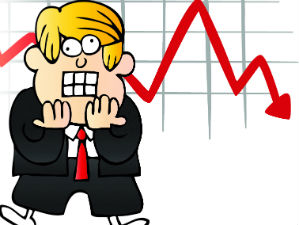Hapless rupee tumbles; RBI helpless, government mindless


| 83.290 |  | United States Dollar |
"If the country has high fiscal deficit and high inflation, and also has high current account deficit, I don't see why the currency will not depreciate," Dr Chakrabarty told reporters on the sidelines of an event hosted by the Central Bank of India and the SME Chamber late last year.
Dr Chakrabarty's views reflect the deteriorating state of the Indian economy, which is ensuring that the rupee plunges into an abyss, makes imports like oil costlier, pushes up inflation, which in turn will choke economic growth.
Up until the same time last year, India was amongst the most favoured nations for investments and the currency was easily amongst the better performing Asian currencies. Today, the currency has hit a low of Rs 57.21. However, that is not the real problem. The real problem is neither the RBI nor the government knows how far it can go.
Economic fundamentals have deteriorated dramatically giving rise to the fall of the rupee. Take the first case pointed out by the Deputy Governor of high fiscal deficit. In his Union Budget for 2011-2012, Pranab Mukherjee had estimated a fiscal deficit at 4.6% of GDP for 2011-2012. As he delivered his budget speech for 2012-2013 he has estimated that the fiscal deficit would be 5.9% of GDP for 2011-2012. The fiscal deficit has gone haywire thanks to mounting subsidies and populist policies.
The second reason as mentioned by Dr K Chakrabarty is the high current account deficit, which has weighed on the rupee. In fact, the current account deficit will be the worst the country has seen in the last eight years. It's likely to come in at 4% of GDP. Inflation too has added to has added to weakening fundamentals by keeping interest rates at elevated levels, giving rise to a rising fiscal deficit, and lower revenue mop-up.
In the first three months, the staggering dollar inflows from foreign institutional investors (FIIs) had prevented the rupee from sliding. In fact, FIIs invested as much as $9 billion in equities which kept the rupee from depreciating. However, these flows have dried up and in April and May FIIs were net sellers, which has added to some pressure on the rupee. In June, thus far FIIs have made modest purchases in equities.
FDI, which was another source of bringing in dollars has also been dismal. In April 2012, FDI had dropped by 41% to a miniscule $1.85 billion.
Foreign investors that bring in dollars, which helps to sustain the rupee have almost been hunted away by policies like the retrospective tax, which has done more harm than good.
Reforms like FDI in multi-brand retail, which would have bought in dollars have been on the backburner. Of course the freefall of the rupee is also in a measure due to global events.
The RBI which can sell dollars in the market may be reluctant to do so and it would like fundamentals to play through. The central bank cannot mindlessly keep selling dollars and erode the forex reserves of the country. It would like to conserve foreign currency and keep its powder dry. In fact, RBI officials have gone on record to say that they would not curb the fall of the rupee, but would only intervene if there was volatility.
Clearly, the onus is not on the RBI - it is on the government. Going forward unless the government initiates reforms and keeps the current account deficit under control, it is unlikely the rupee will appreciate anytime soon.
GoodReturns.in
































